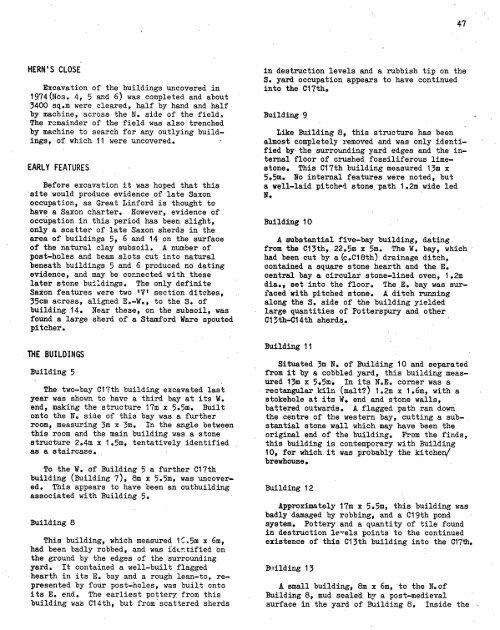Untitled - Council for British Archaeology
Untitled - Council for British Archaeology
Untitled - Council for British Archaeology
You also want an ePaper? Increase the reach of your titles
YUMPU automatically turns print PDFs into web optimized ePapers that Google loves.
- large<br />
47<br />
HERN'S CLOSE<br />
Excavation of the buildings uncovered in<br />
1974(Nos. 4, 5 and 6) was completed and about<br />
3400 sq.m were cleared, half by hand and half<br />
by machine, across the N. side of the field.<br />
The remainder of the field was also trenched<br />
by machine to search <strong>for</strong> any outlying buildings,<br />
of which 11 were uncovered.<br />
EARLY FEATURES<br />
Be<strong>for</strong>e excavation it was hoped that this<br />
site would produce evidence of late Saxon<br />
occupation, as Great Lin<strong>for</strong>d is thought to<br />
have a Saxon charter. However, evidence of<br />
occupation in this period has been slight,<br />
only a scatter of late Saxon sherds in the<br />
area of buildings 5, 6 and 14 on the surface<br />
of the natural clay subsoil. A number of<br />
post-holes and beam slots cut into natural<br />
beneath buildings 5 and 6 produced no dating<br />
evidence, and may be connected with these<br />
later stone buildings. The only definite<br />
Saxon features were two ,V1 section ditches,<br />
35cm across, aligned E.-W., to the S. of<br />
building 14. Near these, on the subsoil, was<br />
found a large sherd of a Stam<strong>for</strong>d Ware spouted<br />
pitcher.<br />
in destruction levels and a rubbish tip on the<br />
S. yard occupation appears to have continued<br />
into the 017th.<br />
Building 9<br />
Like Building 8, this structure has been<br />
almost completely removed and was only identified<br />
by the surrounding yard edges and the internal<br />
floor of crushed fossiliferous limestone.<br />
This 017th building measured 13m x<br />
5.5m. No internal features were noted, but<br />
a well-laid pitched stone, path 1.2m wide led<br />
N.<br />
Building 10<br />
A substantial five-bay building, dating<br />
from the 013th, 22.5m x 5m. The W. bay, which<br />
had been cut by a(c.C18th) drainage ditch,<br />
contained a square stone hearth and the E.<br />
central bay a circular stone-lined oven, 1.2m<br />
dia., set into the floor. The E. bay was surfaced'with<br />
pitched stone. A ditch running<br />
along the S. side of the building yielded<br />
quantities of PottersPury and other<br />
C13th-C14th sherds.<br />
THE BUILDINGS<br />
Building 5<br />
The two-bay C17th building excavated last<br />
year was shown to have a third bay at its W.<br />
end, making the structure 17m x 5.5m. Built<br />
onto the N. side of this bay was a further<br />
room, measuring 3m x 3m. In the angle between<br />
this room and the main building was a stone<br />
structure 2.4m x 1.5m, tentatively identified<br />
as a staircase.<br />
To the W. of Building 5 a further Cl7th<br />
building (Building 7), 8m x 5.5m, was uncovered.<br />
This appears to have been an outbuilding<br />
associated with Building 5.<br />
Building 8<br />
This building, which measured 1.-5m x 6m,<br />
had been badly robbed, and was idLntified on<br />
the ground by the edges of the surrounding<br />
yard. It contained a well-built flagged<br />
hearth in its E. bay and a rough lean-to, represented<br />
by four post-holes, was built onto<br />
its E. end. The earliest pottery from this<br />
building was 014th, but from scattered sherds<br />
Building 11<br />
Situated 3m N. of Building 10 and separated<br />
from it by a cobbled yard, this building measured<br />
13m x 5.5m. In its N.E. corner was a<br />
rectangular kiln (malt?) 1.2m x 1.6m, with a<br />
stokehole at its W. end and stone walls,<br />
battered outwards. A flagged,path ran down<br />
the centre of the western bay, cutting a substantial<br />
stone wall which may have been the<br />
original end of the building. From the finds,<br />
this building is contemporary with Building<br />
10, <strong>for</strong> which it was probably the kitchen/<br />
brewhouse.<br />
Building 12<br />
Approximately 17m x 5.5m, this building was<br />
badly damaged by robbing, and a 019th pond<br />
system. Pottery and a quantity of tile found<br />
in destruction le-rels points to'the continued<br />
existence of this C13th building into the 017ti.<br />
Bnilding 13<br />
A small building, 8m x 6m, to the N.of<br />
Building 8, mud sealed by a post-medieval<br />
surface in the yard of Building 8. Inside the ,

















